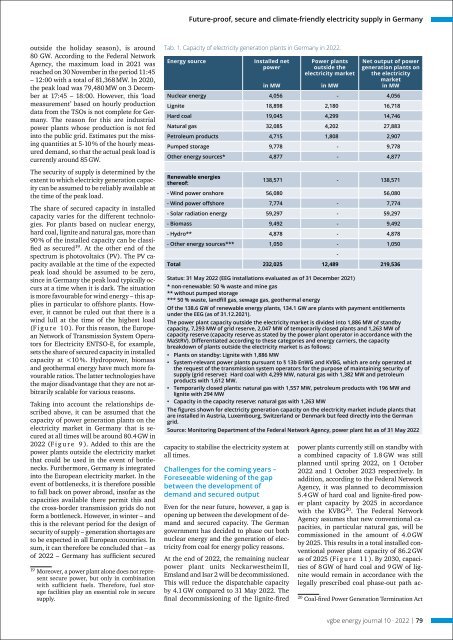vgbe energy journal 10 (2022) - International Journal for Generation and Storage of Electricity and Heat
vgbe energy journal - International Journal for Generation and Storage of Electricity and Heat. Issue 10 (2022). Technical Journal of the vgbe energy e.V. - Energy is us! NOTICE: Please feel free to read this free copy of the vgbe energy journal. This is our temporary contribution to support experience exchange in the energy industry during Corona times. The printed edition, subscription as well as further services are available on our website, www.vgbe.energy +++++++++++++++++++++++++++++++++++++++++++++++++++++++
vgbe energy journal - International Journal for Generation and Storage of Electricity and Heat.
Issue 10 (2022).
Technical Journal of the vgbe energy e.V. - Energy is us!
NOTICE: Please feel free to read this free copy of the vgbe energy journal. This is our temporary contribution to support experience exchange in the energy industry during Corona times. The printed edition, subscription as well as further services are available on our website, www.vgbe.energy
+++++++++++++++++++++++++++++++++++++++++++++++++++++++
Erfolgreiche ePaper selbst erstellen
Machen Sie aus Ihren PDF Publikationen ein blätterbares Flipbook mit unserer einzigartigen Google optimierten e-Paper Software.
Future-pro<strong>of</strong>, secure <strong>and</strong> climate-friendly electricity supply in Germany<br />
outside the holiday season), is around<br />
80 GW. According to the Federal Network<br />
Agency, the maximum load in 2021 was<br />
reached on 30 November in the period 11:45<br />
– 12:00 with a total <strong>of</strong> 81,368 MW. In 2020,<br />
the peak load was 79,480 MW on 3 December<br />
at 17:45 – 18:00. However, this ‘load<br />
measurement’ based on hourly production<br />
data from the TSOs is not complete <strong>for</strong> Germany.<br />
The reason <strong>for</strong> this are industrial<br />
power plants whose production is not fed<br />
into the public grid. Estimates put the missing<br />
quantities at 5-<strong>10</strong> % <strong>of</strong> the hourly measured<br />
dem<strong>and</strong>, so that the actual peak load is<br />
currently around 85 GW.<br />
The security <strong>of</strong> supply is determined by the<br />
extent to which electricity generation capacity<br />
can be assumed to be reliably available at<br />
the time <strong>of</strong> the peak load.<br />
The share <strong>of</strong> secured capacity in installed<br />
capacity varies <strong>for</strong> the different technologies.<br />
For plants based on nuclear <strong>energy</strong>,<br />
hard coal, lignite <strong>and</strong> natural gas, more than<br />
90 % <strong>of</strong> the installed capacity can be classified<br />
as secured 19 . At the other end <strong>of</strong> the<br />
spectrum is photovoltaics (PV). The PV capacity<br />
available at the time <strong>of</strong> the expected<br />
peak load should be assumed to be zero,<br />
since in Germany the peak load typically occurs<br />
at a time when it is dark. The situation<br />
is more favourable <strong>for</strong> wind <strong>energy</strong> – this applies<br />
in particular to <strong>of</strong>fshore plants. However,<br />
it cannot be ruled out that there is a<br />
wind lull at the time <strong>of</strong> the highest load<br />
(F i g u r e <strong>10</strong> ). For this reason, the European<br />
Network <strong>of</strong> Transmission System Operators<br />
<strong>for</strong> <strong>Electricity</strong> ENTSO-E, <strong>for</strong> example,<br />
sets the share <strong>of</strong> secured capacity in installed<br />
capacity at

















